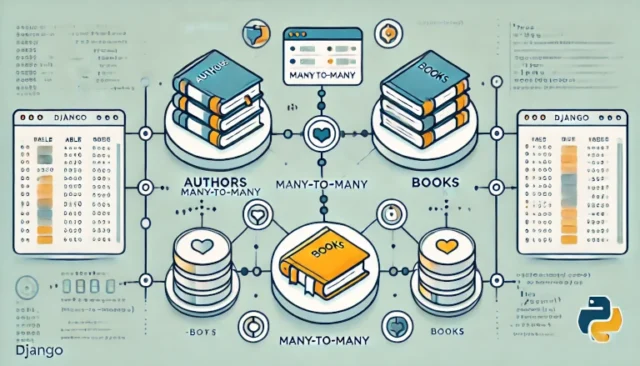When designing databases for modern applications, handling relationships between data models is crucial. One such relationship, the many-to-many relationship, is often used in scenarios where multiple entities can be associated with multiple other entities. For instance, a single user might belong to multiple groups, and a group can have multiple users. In Django, the models.ManyToManyField provides a seamless way to implement this relationship. This guide will walk you through understanding many-to-many relationships, how to implement them using models.ManyToManyField in Django, and their integration with Django Rest Framework (DRF).
What is a Many-to-Many Relationship?
A many-to-many relationship occurs when multiple records in one table are associated with multiple records in another table. This is achieved by using an intermediate table (also known as a junction table) to establish the connections. For example, in a school database:
- A student can enroll in multiple courses.
- A course can have multiple students.
In Django, this relationship is elegantly handled by the models.ManyToManyField, which abstracts away the complexity of managing intermediate tables.
How Many-to-Many Relationships Work in Django
When you declare a models.ManyToManyField in Django, it automatically creates an intermediate table in the database to manage the relationships. This table contains foreign keys to both related tables, enabling the connection between them.
For example:
from django.db import models
class Course(models.Model):
name = models.CharField(max_length=100)
class Student(models.Model):
name = models.CharField(max_length=100)
courses = models.ManyToManyField(Course)
Here, Django automatically creates a junction table to manage the relationship between Student and Course.
Setting Up Many-to-Many Relationships in Django
To implement many-to-many relationships, follow these steps:
- Define the models with a ManyToManyField.
- Apply migrations to create the necessary database tables.
- Use Django’s ORM to add, retrieve, and manage the relationships.
# models.py
from django.db import models
class Author(models.Model):
name = models.CharField(max_length=100)
class Book(models.Model):
title = models.CharField(max_length=200)
authors = models.ManyToManyField(Author)
Run the following commands to create migrations and apply them:
python manage.py makemigrations
python manage.py migrate
Using the Django ORM to Manage Many-to-Many Relationships
Once the models are set up, Django’s ORM makes it easy to interact with many-to-many fields. For instance:
Adding relationships:
author1 = Author.objects.create(name="Author One")
author2 = Author.objects.create(name="Author Two")
book = Book.objects.create(title="Sample Book")
book.authors.add(author1, author2)
Querying relationships:
authors = book.authors.all() # Fetch all authors for a book
books = author1.book_set.all() # Fetch all books written by an author
Removing relationships:
book.authors.remove(author1)
Implementing Many-to-Many Relationships in DRF
In Django Rest Framework, you can expose many-to-many relationships using serializers. For example:
# serializers.py
from rest_framework import serializers
from .models import Author, Book
class AuthorSerializer(serializers.ModelSerializer):
class Meta:
model = Author
fields = '__all__'
class BookSerializer(serializers.ModelSerializer):
authors = AuthorSerializer(many=True)
class Meta:
model = Book
fields = '__all__'
Handling write operations requires an override of the create or update methods to manage many-to-many relationships effectively.
Common Issues and Their Solutions
One frequent issue is forgetting to call save() after adding or removing relationships. Always call save() to ensure changes are reflected in the database. Another issue occurs when attempting to assign objects directly to a many-to-many field. Use the .set() method instead to replace existing relationships.
Example:
book.authors.set([author1, author2])
Why Use Many-to-Many Relationships in Django?
Using models.ManyToManyField simplifies handling complex relationships in your database, reducing boilerplate code and allowing for efficient queries. By leveraging Django’s built-in functionality, you can save time and focus on building features instead of managing database schemas.
Final Thoughts
Understanding and implementing many-to-many relationships in Django is a fundamental skill for developers working with complex data models. With Django’s models.ManyToManyField, you can create, manage, and query these relationships effortlessly, whether you’re building an e-commerce platform, a social network, or any other data-intensive application. Combined with Django Rest Framework, it becomes even more powerful, allowing you to expose these relationships through APIs seamlessly.
